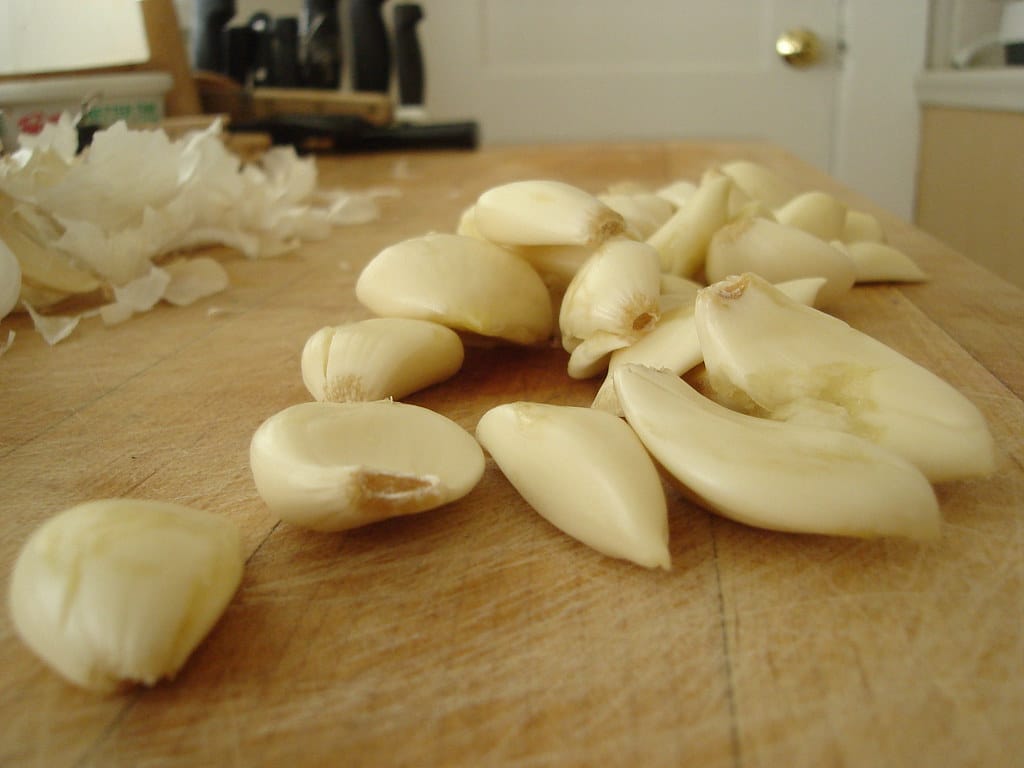Key Takeaways:
- Common clinical signs are gastrointestinal upset, depression, weakness, and dark urine
- 15g garlic/kg body weight can cause significant changes in blood parameters
- Some breeds are more susceptible – eg, Akita, Shiba Inu, Japanese Chin, and Korean Jindo
- Signs of toxicity can take days to appear, depending on how much was ingested
Garlic-associated poisoning generally involves the accidental ingestion of garlic. This is due to a lack of public knowledge that garlic can pose a serious health threat to our canine counterparts.
Garlic is an allium species (Allium sativum) commonly used in human meal preparations. The Organosulfoxides contained within are responsible for garlic toxicity in dogs.
Allium toxicity in my canine patients is relatively common, and there tends to be an uptick in toxicity around this time of year. There’s no specific antidote, and rapid treatment is essential. Read on to learn more about garlic and our canine furbabies.
If your dog has eaten garlic, contact the Pet Poison Helpline at (855) 764-7661 to ascertain the risks to your pet.
How much garlic is toxic to dogs?
Garlic is the most potent of all the allium species being about 5 times more poisonous than onions or leeks.
Just 15g/kg of fresh garlic can cause clinically significant changes in your dog’s red blood cells. Preserved and dried garlic are even more potent, with just 1 teaspoon being the equivalent of about 8 cloves of garlic; this is due to the water having been removed, thus increasing the concentration of toxic thiosulfate.
You may have seen articles and products lauding the benefits of small amounts of garlic for dogs. However, there’s no set amount that’s safe across the board. Some dogs are more susceptible to the toxic effects than others, with certain breeds, such as Shiba Inu and Japanese Chin, being particularly at risk for garlic toxicity.
Just 15g/kg of fresh garlic is enough to be toxic to dogs, with no safe limit of garlic that can be given. Breeds such as Shiba Inu, Korean Jindo, and Japanese Chin are all particularly sensitive to the toxic effects of thiosulfate found in garlic.
What to do if my dog ate garlic?
If your dog managed to sneak a tiny lick of homemade gravy with a small amount of garlic (eg, 1 clove in the entire meal), then they’re unlikely to suffer any major ill effects. In this instance, you should contact Pet Poison Helpline to ascertain the risk of toxicity to your dog.
Then you should monitor them for tummy upsets and abdominal pain over the coming hours and for lethargy or weakness and loss of appetite over the coming days. If any ill effects are observed, then you should contact your DVM for an appointment.
If, however, your pooch has eaten any significant amount (leftovers, garlic bread, etc.) then you should contact your DVM to make an emergency appointment for early intervention. Remember, just because your dog seems fine doesn’t mean the toxic effects of garlic aren’t attacking their blood cells behind the scenes.
If your dog has eaten some garlic, then you should contact the Pet Poison Helpline in the first instance to ascertain whether they may have eaten a toxic dose and need emergency treatment. If you’re certain they’ve eaten a larger amount of garlic, then contact your DVM to make an emergency appointment to start treatment as soon as possible.
When to see a vet?
While the toxic effects of garlic can take some time to appear (up to a week), this doesn’t mean you should delay seeking veterinary treatment for your furbaby. Early treatment will reduce the severity of clinical signs and shorten their duration for your dog, along with improving the prognosis for the survival of your pooch.
Contact your DVM for an urgent appointment if your dog has eaten garlic.
What if my dog ate plenty of garlic but seems fine?
While pooches that have eaten large amounts of garlic may show signs within 24 hours, sometimes these signs can be delayed for up to 1 week after ingestion of small amounts.
Very small amounts may be safe in some animals. You should contact the Pet Poison Helpline to help you determine if your dog ate a toxic amount of garlic. This is particularly important if your dog is a susceptible breed, including Japanese Chin, Korean Jindo, or Shiba Inu.
Firstly you should contact the Pet Poison Helpline to ascertain how much your dog has eaten and their risk of developing clinical signs. Then contact your DVM for an emergency important, especially if you have a susceptible breed pooch.
Signs that my dog got garlic poisoning
The signs of garlic toxicity will vary with the amount of garlic eaten. Any source of garlic is toxic (fresh, dried, liquid, oil, etc.). In fact, dried garlic is much more potent than fresh due to the water having been removed.
Clinical signs of garlic poisoning in dogs include
- Depression
- Anemia
- Pale gums
- Weakness and lethargy
- Exercise intolerance
- Collapse
- Increased heart rate
- Vomiting
- Diarrhea
- Increased salivation
- Abdominal pain
- Dark colored urine
The initial signs noted by dog pawrents are vomiting and diarrhea with abdominal pain. Some dogs may have oral irritation and increased salivation and drooling. Later signs of garlic toxicity include weakness, exercise intolerance, and collapse.
What happens to dogs that eat garlic?
Toxic doses of garlic cause damage to the red blood cells, weakening their cell wall and increasing the risk of them rupturing.
This damage and destruction of the red cells cause anemia which can be fatal in severe cases. Red blood cells are essential for carrying oxygen to the body’s organs, and their deficiency can lead to a lack of oxygenation of these organs, causing damage and, in severe cases, even organ failure.
Garlic toxicity causes the destruction of the body’s red blood cells that carry oxygen to the body’s tissues for essential functions. A lack of red cells impacts this oxygen delivery and can cause serious damage to the body’s organ systems.
Why garlic is toxic to dogs?
Garlic is a member of the Allium family, which contains Organosulfoxides. When chewed, these compounds metabolize into sulfates, including thiosulfate, which cannot be digested properly by our canine companions. Thiosulfate damages the wall of red blood cells, making them fragile and bursting open.
Burst and damaged red cells can’t carry oxygen to the body’s tissues as effectively as normal onces which can lead to a lack of oxygen delivery to important organs such as the heart, brain, and kidneys. A reduced red blood cell count is called anemia and can cause weakness, organ damage, and even death in severe cases.
Reduced numbers of red blood cells cause anemia which can lead to weakness and organ damage. Coupled with direct irritation to the oral cavity and gastrointestinal distress caused by eating garlic, the toxic chemical thiosulfate causes some nasty toxic effects in our canine counterparts.
How do vets treat garlic poisoning?
If your DVM is treating a dog within 2-4 hours of eating garlic, then they may induce vomiting followed by administration of activated charcoal to prevent further absorption of toxins into the bloodstream.
After initial treatment and stabilization, your vet will likely start your dog on intravenous fluids and gastro-protectant medications to help with the toxic effects on the gastrointestinal system. The fluids will help to support your dog’s kidneys in getting rid of the toxic substance thiosulfate and any damaged red blood cells. Dogs suffering from severe clinical signs may need a blood transfusion to treat the anemia.
Your DVM will start with inducing emesis to reduce the severity of clinical signs before supporting your dog to get through the negative effects of thiosulfate. There’s no specific antidote to garlic toxicity, and supportive treatment such as fluids and gastro-protectants are important.
Final Woof
The most potent member of the Allium family, just 15g/kg fresh garlic can cause clinically important changes to your dog’s blood cells, causing toxic effects to be evident.
There’s no known safe threshold of garlic for dogs, so you shouldn’t ever feed any to your dogThis is particularly important to remember if your dog is one of the breeds susceptible to thiosulfate (the active chemical). These include Shiba Inu, Japanese Chin, and Korean Jindo.
If your dog has eaten some garlic or gotten into leftovers containing garlic, then you should first contact the Pet Poison Helpline at (855) 764-7661 to ascertain the risk of toxicity with your dog. Then contact your DVM for an urgent care appointment to start treatment. If the garlic was eaten within 2-4 hours before an appointment, your veterinarian will induce vomiting and administer activated charcoal to minimize the severity and duration of any clinical signs. Further treatment may be required depending on how much garlic your dog has ingested.
Clinical signs of garlic toxicity include tummy upsets, drooling, weakness, lethargy, racing heart rate, and collapse. Luckily, rapid treatment often results in a full recovery being made.


